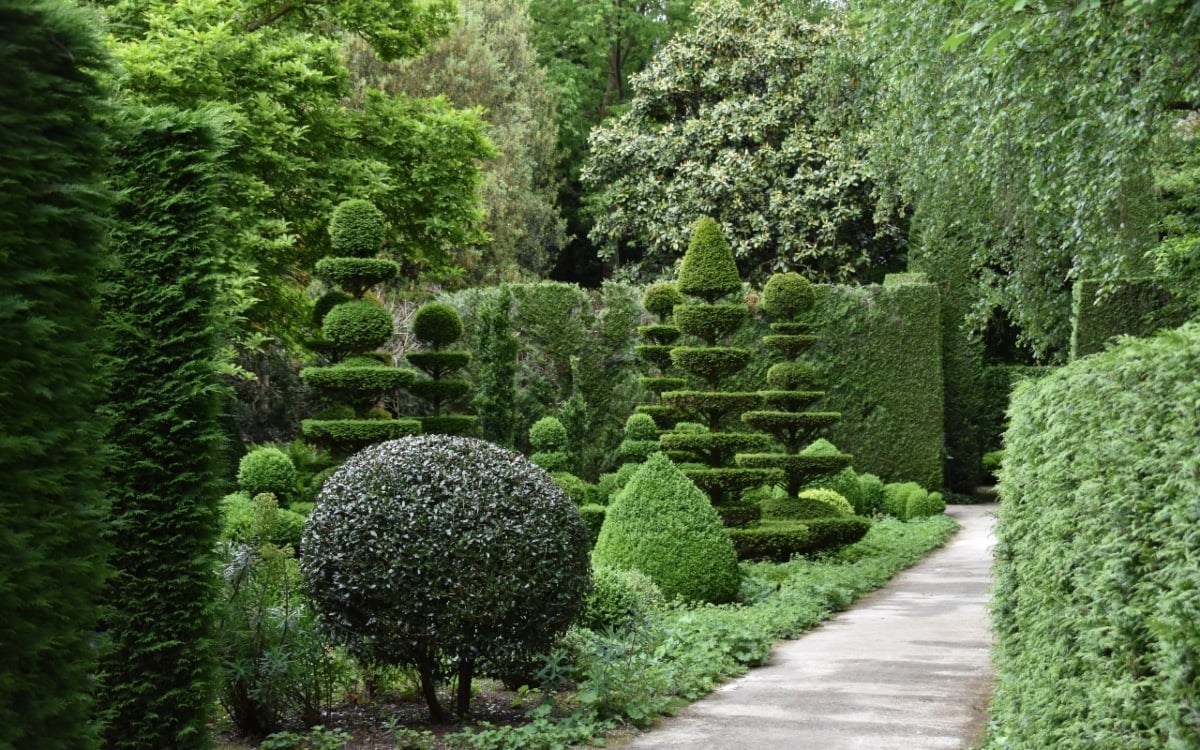
Boxwood shrubs can star in the background in any garden, or they can take a leading role. These versatile evergreen plants can boost curb appeal all on their own or with other plants to accent their beauty. Stay tuned to learn how to care for boxwood shrubs.
Why Choose Boxwood Shrubs?
Boxwood shrubs, so named because their square, or boxy, stems, hail from the box family and are native to Europe, Africa, Asia, South and Central America, Mexico, and the Caribbean. Known for their year-round, green leaves, boxwood shrubs thrive best in plant hardiness zones 5 through 9.
Boxwood (Buxus) shrubs love partial shade — and “alone time.” The only attention they really need is some watering, pruning in the spring or summer to help encourage growth, and a little fall maintenance to keep them healthy during the cold months.
The most common boxwood shrubs in landscape designs are:
- American, or common, boxwood (Buxus sempervirens)
- Japanese boxwood (Buxus microphylla var. japonica)
- English boxwood (Buxus sempervirens ‘Suffruticosa’)
- Korean boxwood (Buxus sinica)
Deer-resistant boxwoods work well with everything from herbs to flowers to vegetables, making them perfect for foundation planting in garden beds. And since these shrubs can grow to a height of up to 8 feet, they’re also a good option for privacy hedges. Keep in mind that, because they are slow-growing, it could take a few years to reach that level of maturity.
How to Landscape with Boxwood Shrubs
The versatility of boxwood shrubs is what makes them such an essential favorite. They come in many sizes and several shapes: rounded, upright, pyramidal, and spreading.
Depending on their size, these shrubs make great:
- Walkway edgers
- Stand-alone statement pieces
- Foundation plantings
- Hedges
- Potted topiaries
Any way you plant them, boxwoods will cast an air of elegance and charm on your yard. They pair well with flowering shrubs such as azaleas and hydrangeas, mixing color with the boxwood’s green and variegated hues. Lilacs can also add color amid your boxwoods. Annuals, perennials, and even vegetables look amazing with them.
Boxwood shrubs can serve as hedges, offer privacy, and accent your landscape or showcase your topiary skills. You don’t have to be Edward Scissorhands to shape — or care — for these shrubs.
How to Plant Boxwood Shrubs
For your boxwoods to live a healthy life, plant them in the right place. Consider your property’s climate and soil when laying out your plans.
When and where to plant
Boxwood shrubs can be planted in the spring or fall. They need well-drained, nutrient-rich soil to flourish, so cultivating these plants away from wet areas is a must.
It’s best to plant your shrubs where the soil pH ranges between 6.8 and 7.5, the American Boxwood Society says. Plant boxwoods where they can receive shade from the afternoon sun.
How far to space plants
The space between your shrubs depends on their spread. Plant them far enough apart to give them room to grow to their mature size.
How to plant
Boxwoods have shallow root systems. Plant your shrubs in a hole double the size of, and slightly deeper than, the root ball. Place them under a shallow layer of soil, with the crown, or where the roots meet the stem, slightly above.
How to mulch
Surround them with 2 to 3 inches of mulch but not near the crown. This organic matter supplies nutrients to help your plants thrive.
After planting
Deep-water new plants at least weekly for the first 2 years.
Gardening Tip: Do you live in an area prone to high heat? Find a spot hit by a good dose of afternoon shade. Plagued by winter winds? Choose a site offering protection.
How to Maintain Boxwood Shrubs
Your shrubs should be pretty low maintenance, needing water once or twice a week, depending on the rain. Boxwoods need care during the following seasons:
- Spring and Summer: Using your shears, prune new growth, thin to allow the sun to reach the inner plant, and fertilize the root zone (but not too much) in the early spring, before the growing season. Monitor for bugs and diseases. Water at least once a week during the dry season.
- Fall: Water and mulch before the first freeze to prevent winter dehydration. Approximately 2-3 inches of mulch conserves moisture and helps keep the shrubs from becoming thirsty during the winter. Deposit the mulch 2 inches away from the crown.
Some sites, such as the New York Botanical Garden, propose lightly wrapping boxwood shrubs for winter protection. However, the American Boxwood Society doesn’t mention such practices but instead recommends wrapping shrubs that have weak stems with nylon cord to protect them from ice or heavy snow.
- Winter: Pruning boxwoods in the cooler months can harm new shoots, and cutting too much at once can trigger winter growth. Wait until spring to prune bronzing damage.
Gardening Tip: Beware of sun damage in wintertime. “Winter bronzing,” a result of sun and wind, is caused by water loss that leads to orangish-yellow foliage.
How to Identify Threats to Boxwood Shrubs
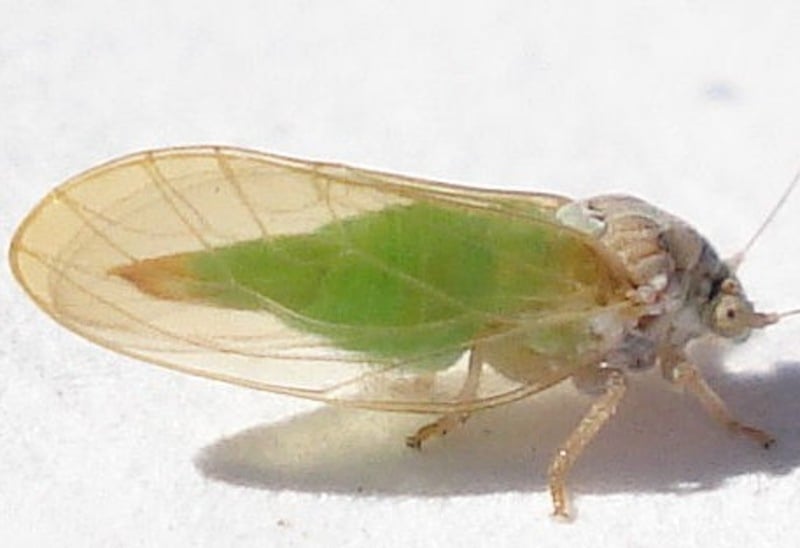
Although generally trouble-free, boxwoods can attract pests and diseases. Here’s how to spot both.
Pests
- Boxwood leafminer (Monarthropalpus flavus): A larva occurring throughout the United States, the boxwood leafminer is considered the worst of this shrub’s pests. Leaves’ topsides become blotchy and yellowish, and the undersides have blistering. Larvae live between the leaf layers.
- Boxwood psyllid (Psylla buxi): The most common insect infesting boxwood shrubs, infestation with the boxwood psyllid can occur anywhere in the United States. When the shrub is infested, insects can be seen within cupped leaves.
- Box tree moths (Cydalima perspectalis): Existing in Canada and the United States (for now, only in New York), box tree moths lay eggs in mid-March, hatching into green caterpillars that form cobwebs over the shrub and eaten, brown leaves. Pupae then open to emit a whitish moth with brown edges.
- Boxwood mites (Eurytetranychus buxi): Boxwood mites are a type of spider mite, tiny arachnids that attach to the underside of leaves. These pests give the leaves a spotted or streaked appearance.
Diseases
- Boxwood blight: Found in at least 27 states, the fungus Cylindrocladium buxicola causes boxwood blight, a disease in which the leaves develop brown or tan spots. The spots enlarge, ultimately causing leaves to eventually brown and drop off. The stems of the plant exhibit black streaks.
- Root rot: A disease caused by Phytophthora fungus species, root rot results from soggy soil around the crown and roots. The leaves pale and drop, and the crown turns brown or gray. Good drainage helps prevent this fungal disease.
Treatment
Depending on the severity of the pest or disease, you can encourage predators such as green lacewings and spiders, prune the affected leaves, or use pesticides. The best deterrent is prevention. If you’d rather not worry about these pests and diseases, choose one of the boxwood varieties naturally resistant to infestations and infections.
Take a look at our picks below to help you get started.
5 Types of Boxwood Shrubs
Although the five types of boxwoods described below may be susceptible to some diseases and pests, they are more low risk than other varieties.
1. Vardar Valley
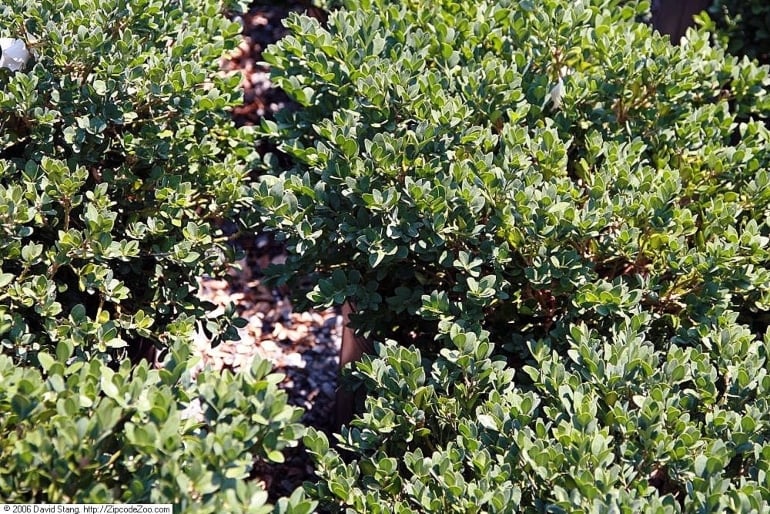
Vardar Valley’s evergreen leaves have a leather-like texture and oblong shape. This boxwood is a great option for attracting pollinators. Like many evergreen shrubs, this boxwood variety works well as a foundation hedge. Bonus: Vardar Valley is resistant to disease and pests, such as blight and boxwood leafminer.
Hardiness zone: USDA Plant Hardiness Zones 5b through 8
Color: Pale green flowers in spring; evergreen leaves can have a bluish or golden tint
Sun tolerance: Full sun most of the day, followed by a short period of partial shade
Drought tolerance: High; a hardy plant, it can flourish during dry periods
Soil type: Well-drained clay or sandy soil
Height: 2 to 3 feet
Spread: 3 to 6 feet
2. Pyramidalis
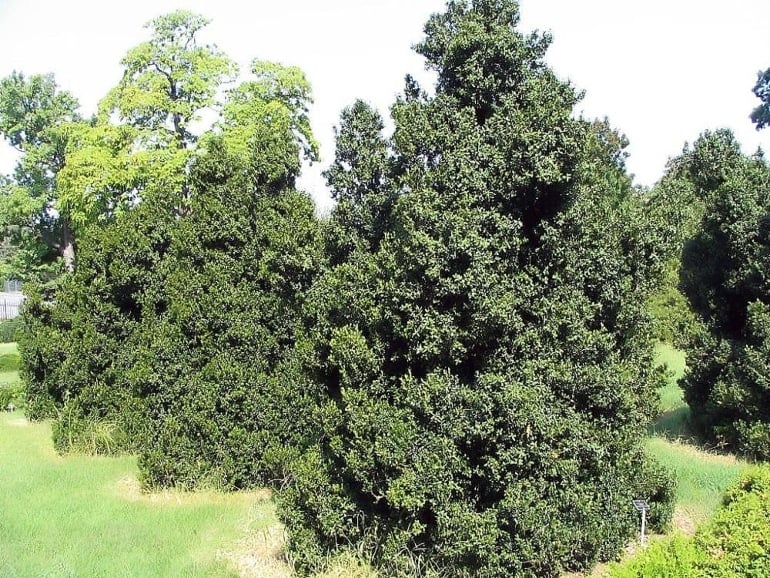
Pyramidalis, as its name suggests, naturally grows in the shape of a cone or pyramid. This common boxwood also attracts pollinators and is resistant to pests. Use pyramidalis as a decorative topiary or boxwood hedge.
Hardiness zone: USDA Plant Hardiness Zones 5 through 8
Color: Dark green
Sun tolerance: Full sun and partial shade
Drought tolerance: Moderate; needs regular watering to keep the soil moist
Soil type: Tolerates most soils, but prefers clay or sand
Height: Up to 12 feet
Spread: 8 feet
3. Green Beauty
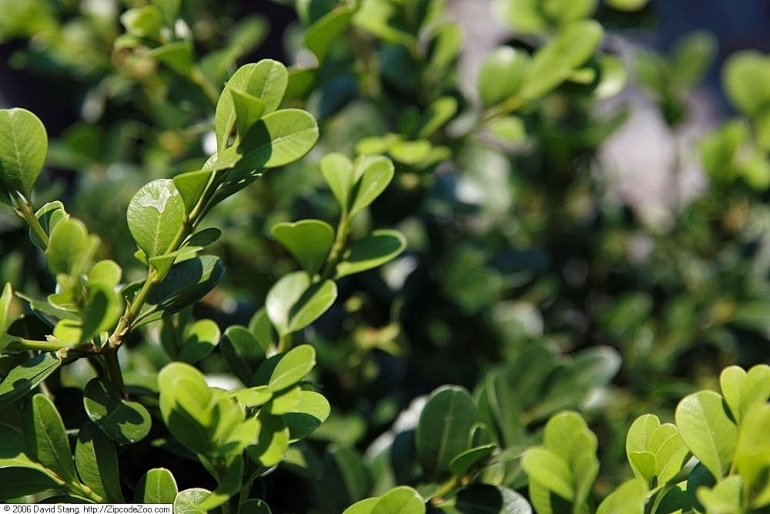
Green Beauty, a Japanese boxwood, is at low risk for blight and tolerant of pests. This boxwood grows in a rounded shape. Green Beauty is best planted as a landscape accent or garden or walkway border.
Hardiness zone: USDA Plant Hardiness Zones 6 through 9
Color: Green
Sun tolerance: Partial shade; can grow in full shade but not to its full potential
Drought tolerance: Good for short periods of dryness but must be watered during drought
Soil type: Well-drained mix of sand and clay with slight acidity or alkalinity
Height: Up to 3 to 5 feet
Spread: 3 to 5 feet
4. Fastigiata

Fastigiata, when compared to other boxwoods, can appear more like a tree than a typical shrub. It grows in a column shape. With a lifespan of 40-plus years, this low-maintenance plant can be a part of your landscape for decades. Boasting glossy, rounded leaves, Fastigiata works well as hedging or as a potted, decorative accent.
Hardiness zone: USDA Plant Hardiness Zones 6 through 8
Color: Blue-green to dark green
Sun tolerance: Full sun and partial shade; too much full sun may scorch leaves
Drought tolerance: Moderate, but still needs watering throughout the year
Soil type: Prefers moist, alkaline soils
Height: Up to 12 feet
Spread: 4 to 5 feet
5. Korean Boxwood
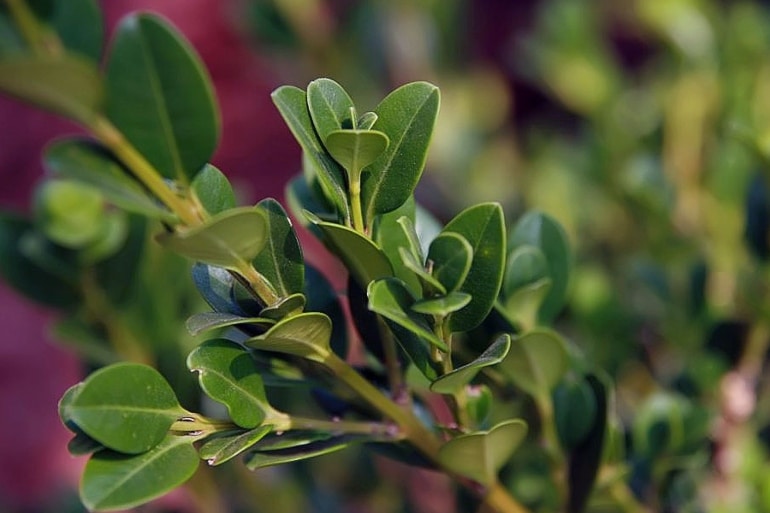
Korean boxwood shrubs, also known as Buxus sinica var. insularis, are perfect for edging garden beds. These shrubs are shaped as small mounds and have small, shiny leaves.
Hardiness zone: USDA Plant Hardiness Zones 4 through 9
Color: Greenish-yellow
Sun tolerance: Full sun and partial shade
Drought tolerance: Yes, but still needs watering
Soil type: Prefers medium moisture in sandy loams
Height: 2 to 2½ feet
Spread: 4 to 5 feet
FAQ About Boxwood Shrubs
In a word, yes. In the first 2 years after planting, they require a bit of attention: careful watering and pruning. Afterward, they need weekly watering, some pruning, and a little maintenance to prepare them for winter.
Both. Give them the morning sun. Don’t plant your boxwoods in the hot afternoon sunshine. At this time of day, they like shade.
Drought stress and winter bronzing can cause the leaves of your boxwood to become brown or yellow. Pests such as leafminer and diseases such as boxwood blight and root rot can also cause your leaves to change color.
Certainly. Topiary boxwoods in containers indoors or outdoors need the same basic care as boxwoods planted in your garden. You’ll need to plant them in a pot big enough for growth, and they’ll need more attention to pruning to keep them in the shape you desire.
In general, boxwoods are safe around animals. But if your cat, dog, or horse likes to chomp on plants, boxwoods can be harmful. Cats and dogs may vomit and have diarrhea. Horses may exhibit diarrhea, colic, seizures and respiratory failure. Call your vet if you observe your pet eating boxwoods or your pet has signs and symptoms of toxicity.
How to Get Help With Your Boxwoods
With their ease of care, long lives, and multiple functions, boxwood shrubs can be the stars of your yard or the background players. They are ideal for novice and experienced landscapers (and topiary artists) alike.
But if you’re not sure how to use boxwood shrubs in your plans for your yard or if you have grand plans for your lawn but want the help of an expert, call a landscaping pro near you for advice.
Main Image Credit: Pxfuel